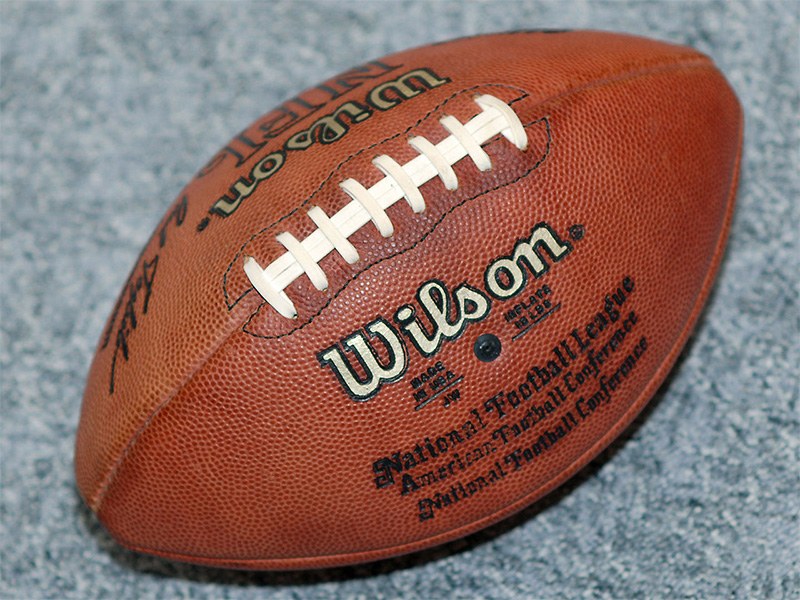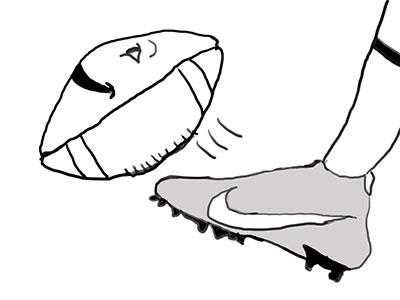
Last month, we looked at some of the basics of the game, including the playing positions, along with some jargon. Now, let’s deal with how the game is played.
Downs
While the ultimate goal is to advance into the end zone for a touchdown, the offensive team has four tries to advance ten yards (i.e., make a first down) before it has to turn the ball over to the defense. This usually means the team tries three times (three downs) to pass or run the ball before not making ten yards and then handing off the ball to the defense. On the fourth attempt, or “fourth down,” the offense usually punts the ball to get it as far into the other team’s territory as it can.
Get a free sample proofread and edit for your English document.
Two professional proofreaders will proofread and edit your English document.
When a ball is punted, the kicking team cannot catch the ball unless it has been touched, but not caught, by the receiving team.
If the team’s entire turn with the ball (i.e., possession) only results in three downs and a punt, that’s called a “three and out.”
So, the game ball’s status is shown by the current number of the down and the yards needed to make the next first down, such as “second down and three” (the second of four available attempts to make ten yards with three yards to go to make that next first down).
When a team makes a first down, it then has another four tries to make another ten yards, leading to the cheer, “First and ten, let’s do it again.”
Other phrases are “third and long” (meaning the third attempt to make a first down with many yards to go), and “second and short” (meaning the second attempt to make a first down with less than a yard to go).
When a team makes a first down and gets closer to the end zone than ten yards, it is described as having X number of yards “and goal,” as in “three and goal.”
“Down” is a noun, as in “making a first down” or being on the “second down.” If the quarterback “downs the ball,” that means they intentionally throw the ball away to avoid a sack (being tackled behind the line of scrimmage) or a turnover, which is an interception (the passer throws the ball, and the opposing team catches it) or fumble (the offense drops the ball and the other team picks it up).
When the offense decides not to punt the ball on fourth down but to run or pass in an attempt to get that first down (often when the drive is at “fourth [down] and inches [to make the first down]”), it’s called “going for it,” as in, “It’s fourth and inches, but the kicker isn’t on the field. Are they going to go for it?”
Tackling
In touch (or flag) football, players take out the opposing player when they remove the opponent’s flag from their waist. In college and pro football, players have to take their opponent down. Once their head, elbow, knee, or anything that isn’t a foot or hand hits the ground, they’ve been tackled, and play is over.
Quarters
Quarters last fifteen minutes, for a total of one hour of play. When the first quarter is over, the teams change sides. (This makes things fairer if there’s some sort of advantage due to the sun or wind or whatever.) Then there’s a second quarter, or the end of the “half,” and “halftime,” which is a fifteen-minute break (half-hour for the Super BowlTM) before the third quarter, or second half. After this, there’s another switch of sides, and then the fourth quarter.
I should note that of that hour, there are about eleven to twelve minutes of actual play action. The rest of the time is spent waiting for the play clock (thirty seconds between plays) to wind down while the teams work out offensive and defensive positions, plan strategy, and generally take care of business. This is why people sometimes call the game “physical chess.” If the offensive team doesn’t snap the ball in time, it gets a penalty for “delay of game.”
Time-Outs
While the play clock counts off play time, there are many ways the clock is stopped. Time-outs are how the teams say, “We need more than thirty seconds for the next play.” Each team gets three time-outs per half, and each time-out is two minutes long. Any unused time-outs expire at the half. Teams can’t use a time-out twice in a row on the same run of downs.
The clock also stops, usually, if someone is hurt or the referees (refs) want to confer on a call.
Sometimes a time-out is called just before a major play to “ice” a player and make them more prone to overthink the play and make a mistake. In particular, before a field goal, teams like to ice the kicker, so they’ll wait until the kicker is about to move forward on the play, then call a time-out.
Two-Minute Warning
At the end of the second and fourth quarters, teams are given a “free” time-out when two minutes or less is left in the quarter after a play ends.
Overtime
If an hour of play results in a tie, the game goes into overtime. It’s an extra ten minutes of play that stops if someone makes a decisive play. The rules about overtime have changed quite a bit over the years, but currently, if the first team to play in overtime scores a touchdown, it wins. If the first team doesn’t score or only makes a field goal, the other team gets the ball for a full run of downs or possession.
To determine who gets the ball at the beginning of the game or in overtime, the refs flip a coin, and the visiting team captain calls heads or tails.
Sudden Death
This was more common under previous overtime rules, but it basically means that whoever scores next wins.
Plays
There are four basic kinds of plays: the kickoff, running, passing, and punting.
The kickoff starts off play in the first and third quarters or whenever one team has scored and the other team is ready to start its series of plays (i.e., drive). The placekicker (because the ball is teed up rather than snapped to the holder, as in a field goal or extra point) kicks the ball down the field.

A player on the receiving team catches the ball and tries to run it back as far as they can before they get tackled. This used to be the most exciting play of the game, but recent rule changes mean that the ball usually ends up in the receiving team’s end zone, which means the next play will be on the twenty-yard line. Also, when the ball is kicked high (i.e., has a long “hang time), the kicking team will usually reach the receiver about the same time as the ball. The receiver can then signal a “fair catch,” which means play will start where the catch is made with no need for tackling.
A running play happens when the quarterback hands off the ball to a running back or hangs on to it (i.e., the “quarterback sneak”) and runs down the field.
In a passing play, the quarterback throws the ball to a designated receiver. The quarterback usually must throw from behind the line of scrimmage, but the receiver can be anywhere. If a pass happens after the line of scrimmage has been crossed by any player with the ball, it must be either thrown sideways (for a lateral) or behind the passer.
If the receiver catches the ball, takes control of the ball (i.e., properly secures the ball in their hands or arms), and maintains control of the ball while being tackled, this is a reception. If they miss the ball or don’t control the ball while being tackled, this is an incomplete pass. If they catch the ball, secure the ball, and then lose the ball before or while being tackled, this is a fumble. (The same is also true if it’s a runner who does this.)
If the ball is caught by a member of the defense, this is an interception. If a team intercepts the ball and then makes a touchdown on that same drive (i.e., possession), it’s called a “pick six.”
A punt happens when the offense decides to hand over the ball (pretty much always on fourth down) to the other team and get the ball as deep into enemy territory as possible.
Onside Kick
It’s understood that a kickoff is a means of giving the ball to the other team, but actually, the placekicker is only obligated to kick the ball ten yards before their own team can recover the ball. An onside kick is intentionally only ten yards or a bit more. It’s a risky move because the other team can take over the ball with excellent field position, but sometimes it pays off.
Challenge
When the refs make a call on the field and the coach doesn’t like it, they can throw a red flag on the field for a challenge. The refs then have to review the play carefully. If the refs agree with the coach, the call is reversed. (The rule is that they have to have definitive evidence the call was wrong; otherwise, the “call on the field” stands.)
If the refs disagree with the coach’s challenge, it costs the team a time-out. Each team is given two challenges for the whole game, but if both challenges by one team are upheld, that team gets a third.
Whew! Next month, we’ll talk divisions, schedules, and penalties.
Julia H.
Get a free sample proofread and edit for your English document.
Two professional proofreaders will proofread and edit your English document.
Get a free sample proofread and edit for your document.
Two professional proofreaders will proofread and edit your document.
We will get your free sample back in three to six hours!